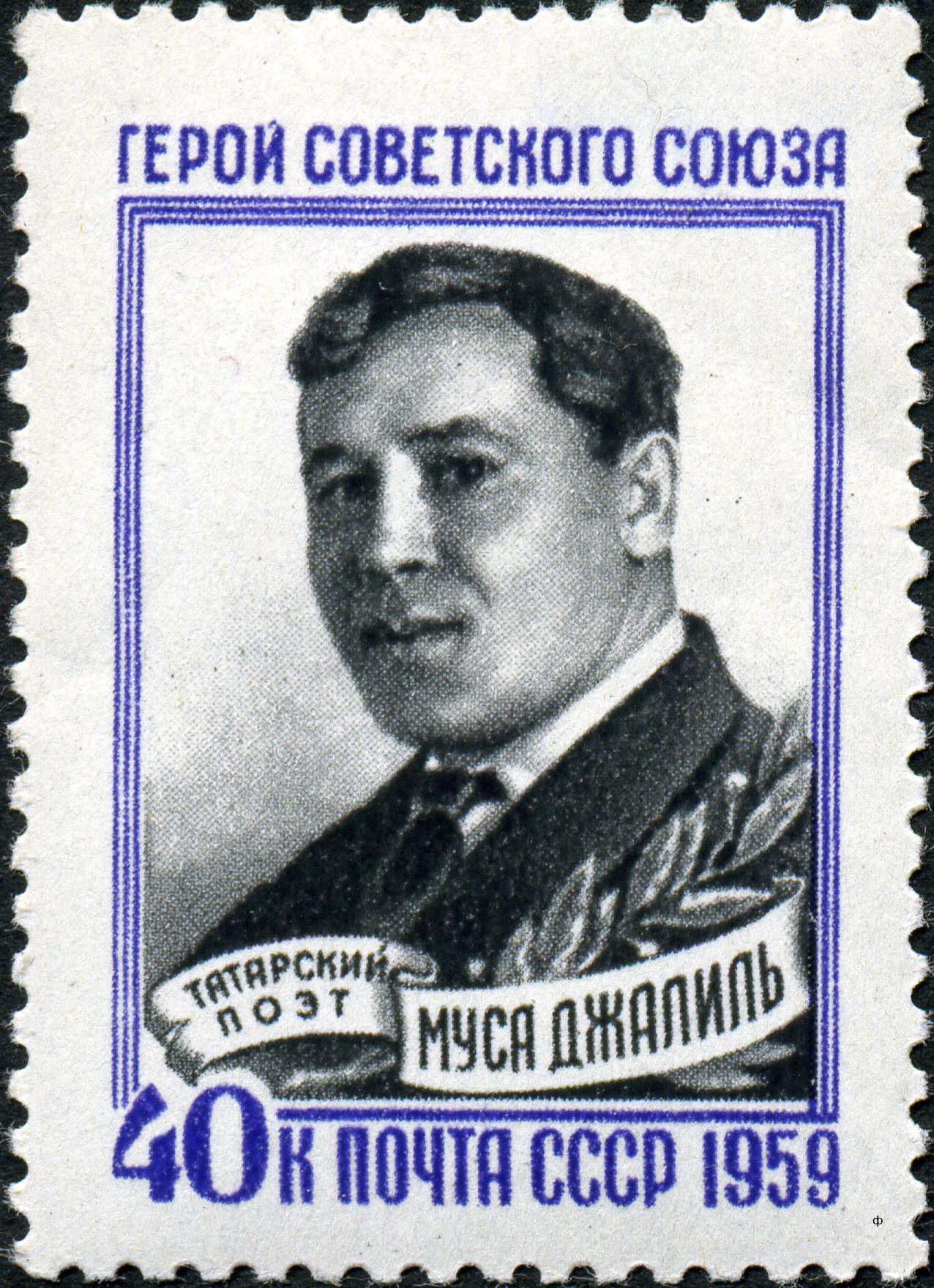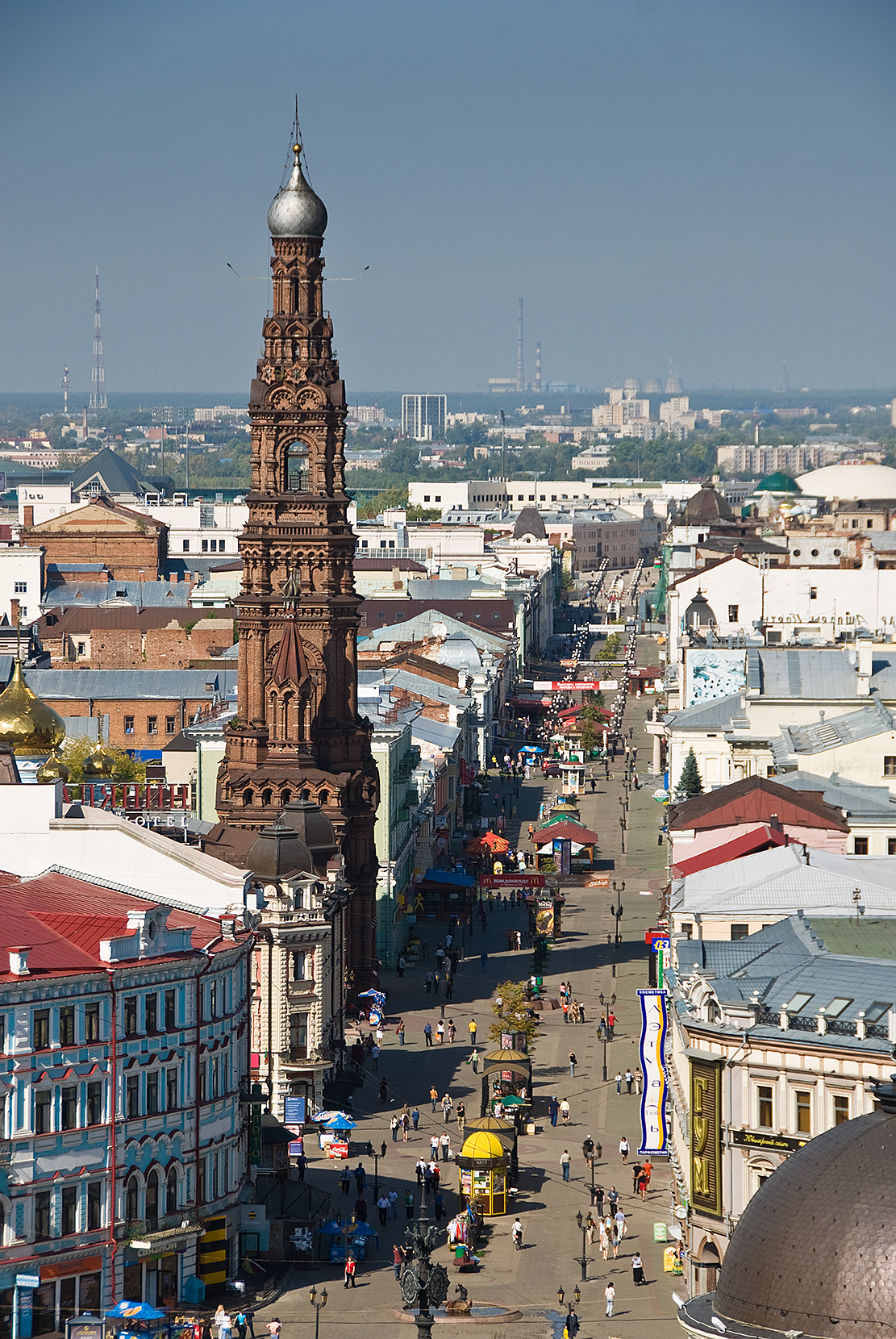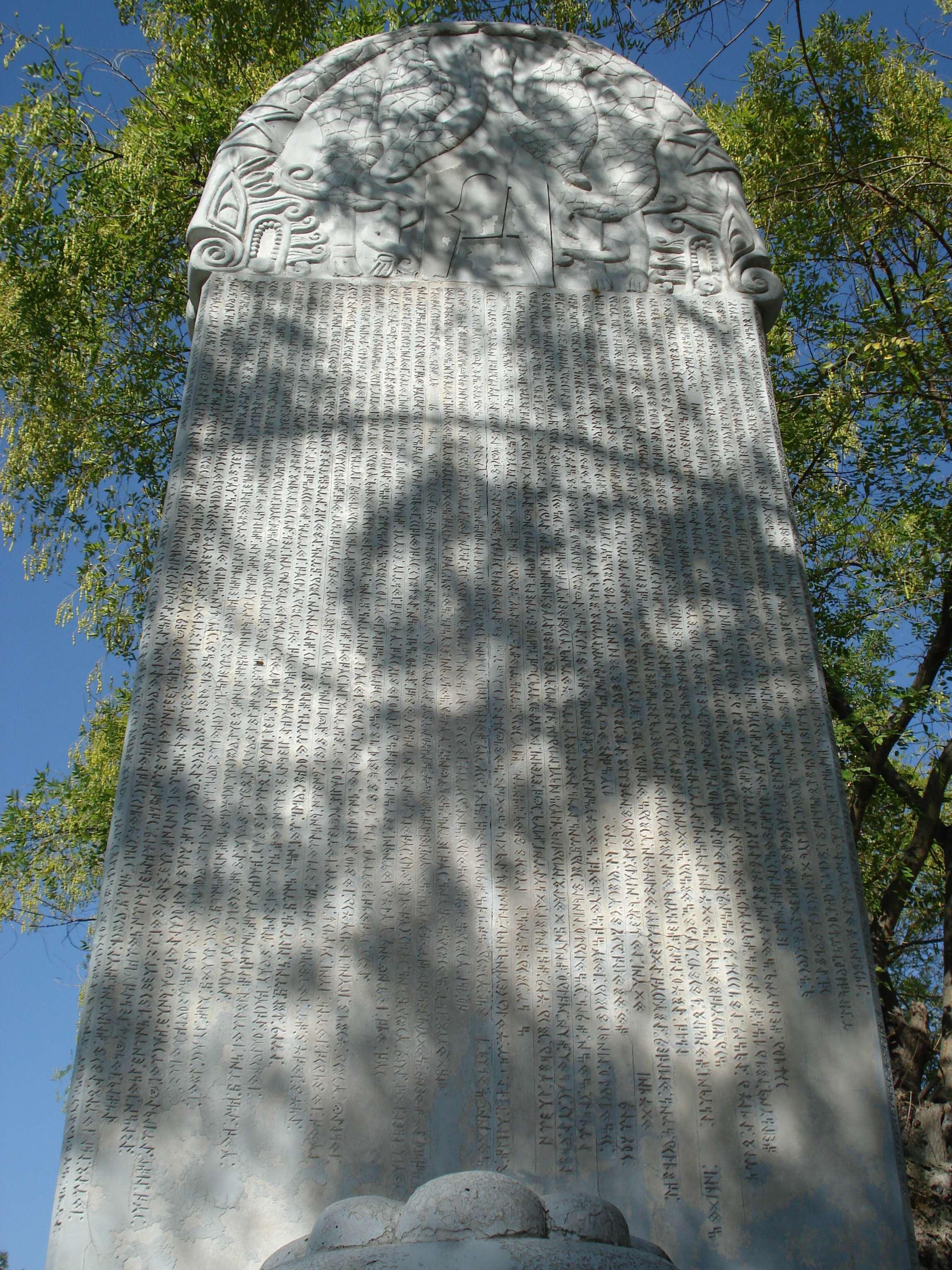|
Kremlyovskaya (Kazan Metro)
Kremlyovskaya (russian: Кремлёвская) is a station of the Kazan Metro. It was opened as part of the first stage of the system on 27 August 2005, as the system's northern terminus. The route has since been extended and it now serves as an intermediate stop. Named after the Kazan Kremlin which is located nearby, architects R.Nurgalieva and S.Mamleyeva along with artist N.Khaziakhmetov incorporated a standard sub-surface single vault technology into the theme of the mythical fortress of the ancient Kazan Khanate. The station walls (which are made from real stone blocks), are faced with beige ''Janina'' marble, and arranged in a geometry to create a white stone illusion. The walls are further topped by defensive "teeth", behind which lie the lighting elements. The walls themselves feature a set of "towers" and in their archways are mosaic artworks on the theme of everyday life in the Bulgarian and Kazan khanates. Whilst the archways located midway between the towers contai ... [...More Info...] [...Related Items...] OR: [Wikipedia] [Google] [Baidu] |
Tatarstan
The Republic of Tatarstan (russian: Республика Татарстан, Respublika Tatarstan, p=rʲɪsˈpublʲɪkə tətɐrˈstan; tt-Cyrl, Татарстан Республикасы), or simply Tatarstan (russian: Татарстан, tt-Cyrl, Татарстан), sometimes also called Tataria (russian: Татария, tt-Cyrl, Татария), is a Republics of Russia, republic of Russia located in Eastern Europe. It is a part of the Volga Federal District; and its capital city, capital and largest city is Kazan, an important cultural centre in Russia. The republic borders Kirov Oblast, Kirov, Ulyanovsk Oblast, Ulyanovsk, Samara Oblast, Samara, and Orenburg Oblasts, the Mari El Republic, Mari El, Udmurt Republic, Udmurt, and Chuvash Republics, and the Bashkortostan, Republic of Bashkortostan. The area of the republic is . The unofficial Tatarstan motto is ''Bez Buildırabız!'' (''We can!''). As of the Russian Census (2021), 2021 Census, the population of Tatarstan was& ... [...More Info...] [...Related Items...] OR: [Wikipedia] [Google] [Baidu] |
Central Stadium (Kazan)
The Central Stadium (russian: Центральный стадион, tt-Cyrl, Үзәк стадион) is a multi-purpose stadium in Kazan, Russia. It is currently used mostly for football matches and is the home ground of FC Rubin Kazan FC Rubin Kazan (russian: Футбо́льный клуб Руби́н Каза́нь, ''Futbolny klub Rubin Kazan'' , Tatar language, Tatar: Рубин Казан) is a Russian professional association football, football club based in the city o .... The western half of the tribunes is covered with a canopy. In 2010, the stadium gained Four stars classification from UEFA. ... [...More Info...] [...Related Items...] OR: [Wikipedia] [Google] [Baidu] |
Musa Cälil
Musa Cälil ( tt-Cyrl, Муса Җәлил, translit=Musa Çəlil, ; russian: Муса Джалиль; 25 August 1944) was a Soviet–Tatar poet and resistance fighter. He is the only poet of the Soviet Union awarded simultaneously the Hero of the Soviet Union award for his resistance fighting and the Lenin Prize for having written ''The Moabit Notebooks''; both awards were bestowed upon him posthumously.Mussa Jalil. Selected poems. Poetry of Truth and Passion. Rafael Mustafin, translated by Lydia Kmetyuk. Moscow, Progress Publishers, 1981 Biography Early life Musa Cälil was born in Mustafino, a village in Orenburg Governorate, to a family of junk dealers. He graduated from in Orenburg. His first published works were revolutionary verses. The Turkic '' aruz wezni'' poetic rhythm is seen in Cälil's early works, which is attributed to ''Gisyanism'' (; гыйсъянизм), a romantic poetic style celebrating revolution that was often found in young Tatar poetry of the 192 ... [...More Info...] [...Related Items...] OR: [Wikipedia] [Google] [Baidu] |
Nikolai Chernyshevsky
Nikolay Gavrilovich Chernyshevsky ( – ) was a Russian literary and social critic, journalist, novelist, democrat, and socialist philosopher, often identified as a utopian socialist and leading theoretician of Russian nihilism. He was the dominant intellectual figure of the 1860s revolutionary democratic movement in Russia, despite spending much of his later life in exile to Siberia, and was later highly praised by Karl Marx, Georgi Plekhanov, and Vladimir Lenin. Biography The son of a priest, Chernyshevsky was born in Saratov in 1828, and stayed there until 1846. He graduated at the local seminary where he learned English, French, German, Italian, Latin, Greek and Old Slavonic. It was there he gained a love of literature. At St Petersburg University he often struggled to warm his room. He kept a diary of trivia like the number of tears he shed over a dead friend. It was here that he became an atheist. He was inspired by the works of Hegel, Ludwig Feuerbach and Charles ... [...More Info...] [...Related Items...] OR: [Wikipedia] [Google] [Baidu] |
Bauman Street (Kazan)
Bauman Street (russian: улица Баумана; tt-Cyrl, Бауман урамы) is a pedestrian street in the heart of Kazan, the capital of Tatarstan, Russia. It is named after Nikolay Bauman, a Russian revolutionary, and is located in the central part of the city. The street starts at the foot of the Kremlin and reaches Tukay Square, the central square in the city. Bauman Street is paved with multicoloured bricks; some benches and two lines of lanterns are set there. There are also planted lindens on the street. Different fairs and festive presentations are held on Bauman Street. History Bauman Street has long been regarded a trading centre and featured a concentration of the main mercantile establishments of the city. The street was the second most significant street of Kazan's central district. It was famous for its banks and notary offices, different shops, drugstores, and hotels. At the beginning of the twentieth century there was a shop in every building. Bauma ... [...More Info...] [...Related Items...] OR: [Wikipedia] [Google] [Baidu] |
Bolaq
The Bolaq ( tt-Cyrl, Болак, translit=Bolaq; russian: Булак, ''Bulak'') is a canal that once flowed from the northern part of Birge Kaban to Kazanka. Today it is an isolated channel in downtown Kazan. The modern length of Bolaq is , and the width is . As a street Bolaq, or, more correctly, Uñ yaq Bolaq/Pravobulachnaya and Sul yaq Bolaq/Levobulachnaya streets is a major arterial road in Central Kazan. Etymology ''Bolaq'' or ''Bulak'', the Russian spelling, refers also for two streets, that are the embankments of the channel: Left Bolaq (Sul yaq Bolaq/Levobulachnaya; Cyrillic:Сул Болак/Левобулачная) and Right Bolaq (Uñ yaq Bolaq/Pravobulachnaya; Cyrillic:Уң Болак/Правобулачная). The origin of the word ''bolaq'' is disputed. Some claim that this comes from ''balaq'', i.e. "arm". Another state that "bolaq" is an Old Tatar/Bulgar for "brook" and could be found in several modern hydronyms of Tatarstan. Natural history Bolaq, as a ... [...More Info...] [...Related Items...] OR: [Wikipedia] [Google] [Baidu] |
Kazan Kremlin Exterior View 08-2016 Img2
Kazan ( ; rus, Казань, p=kɐˈzanʲ; tt-Cyrl, Казан, ''Qazan'', IPA: ɑzan is the capital and largest city of the Republic of Tatarstan in Russia. The city lies at the confluence of the Volga and the Kazanka rivers, covering an area of , with a population of over 1.2 million residents, up to roughly 1.6 million residents in the urban agglomeration. Kazan is the fifth-largest city in Russia, and the most populous city on the Volga, as well as the Volga Federal District. Kazan became the capital of the Khanate of Kazan and was conquered by Ivan the Terrible in the 16th century, becoming a part of Russia. The city was seized and largely destroyed during Pugachev's Rebellion of 1773–1775, but was later rebuilt during the reign of Catherine the Great. In the following centuries, Kazan grew to become a major industrial, cultural and religious centre of Russia. In 1920, after the Russian SFSR became a part of the Soviet Union, Kazan became the capital of the Tatar ... [...More Info...] [...Related Items...] OR: [Wikipedia] [Google] [Baidu] |
Zilant
Zilant ( rus, Зилант; tt-Cyrl, җылан , translit=cılan/jılan, lit=snake) is a legendary creature, something between a dragon and a wyvern. Since 1730, it has been the official symbol of Kazan. This winged snake is mentioned in legends about the foundation of Kazan. A Zilant is a legendary creature with the head of a dragon, the body of a bird, the legs of a chicken, the tail of a snake, the ears of a canine, the red wings of a bat or bird, sharp teeth, dark-gray feathers and scaly dark-gray skin. Nomenclature and etymology The word ''Zilant'' is the English transcription of Russian ''Зилант'', itself a rendering of Tatar ''yılan/елан'', pronounced (or sometimes ) and meaning a snake. The Tatars themselves, on the other hand, frequently refer to this creature with the Persian word '' Ajdaha'' (dragon) or ''Ajdaha-yılan'' (''Dragon-snake''). Tatars regarded it as a repulsive creature, corresponding to European and Persian dragon. According to Idel-Ural ... [...More Info...] [...Related Items...] OR: [Wikipedia] [Google] [Baidu] |
Tatars
The Tatars ()Tatar in the Collins English Dictionary is an umbrella term for different Turkic ethnic groups bearing the name "Tatar". Initially, the ethnonym ''Tatar'' possibly referred to the . That confederation was eventually incorporated into the when unified the various steppe tr ... [...More Info...] [...Related Items...] OR: [Wikipedia] [Google] [Baidu] |
Island Platform
An island platform (also center platform, centre platform) is a station layout arrangement where a single platform is positioned between two tracks within a railway station, tram stop or transitway interchange. Island platforms are popular on twin-track routes due to pragmatic and cost reasons. They are also useful within larger stations where local and express services for the same direction of travel can be provided from opposite sides of the same platform thereby simplifying transfers between the two tracks. An alternative arrangement is to position side platforms on either side of the tracks. The historical use of island platforms depends greatly upon the location. In the United Kingdom the use of island platforms is relatively common when the railway line is in a cutting or raised on an embankment, as this makes it easier to provide access to the platform without walking across the tracks. Advantages and tradeoffs Island platforms are necessary for any station with many th ... [...More Info...] [...Related Items...] OR: [Wikipedia] [Google] [Baidu] |
Islam
Islam (; ar, ۘالِإسلَام, , ) is an Abrahamic religions, Abrahamic Monotheism#Islam, monotheistic religion centred primarily around the Quran, a religious text considered by Muslims to be the direct word of God in Islam, God (or ''Allah'') as it was revealed to Muhammad, the Muhammad in Islam, main and final Islamic prophet.Peters, F. E. 2009. "Allāh." In , edited by J. L. Esposito. Oxford: Oxford University Press. . (See alsoquick reference) "[T]he Muslims' understanding of Allāh is based...on the Qurʿān's public witness. Allāh is Unique, the Creator, Sovereign, and Judge of mankind. It is Allāh who directs the universe through his direct action on nature and who has guided human history through his prophets, Abraham, with whom he made his covenant, Moses/Moosa, Jesus/Eesa, and Muḥammad, through all of whom he founded his chosen communities, the 'Peoples of the Book.'" It is the Major religious groups, world's second-largest religion behind Christianity, w ... [...More Info...] [...Related Items...] OR: [Wikipedia] [Google] [Baidu] |








.jpg)